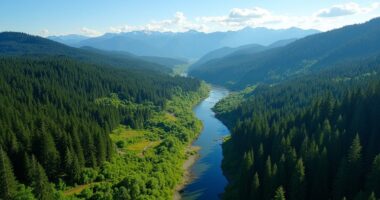Brazil has rolled out a bold $2 billion initiative to revitalize one million hectares of degraded land. Think of it as a hefty dose of eco-friendly vitamins for Mother Nature! The plan blends public and private investments, with Brazil’s Climate Fund kicking in $1 billion and private investors adding at least $1.5 billion. This project doesn’t just aim for greener pastures; it addresses social inclusion and sustainable farming. Curious to learn about the goals and impact? Keep on exploring!
Brazil’s $2 Billion Land Restoration Initiative
In the vibrant tapestry of environmental initiatives, Brazil’s Sustainable Finance Initiative for Land Restoration stands out like a bright green thumbprint on a canvas of beige bureaucracy.
This ambitious $2 billion project aims to breathe life back into 1 million hectares of degraded land, a task that sounds Herculean, but is more about teamwork than solo heroics.
At the heart of this initiative lies an auction-based, blended-finance model designed to attract both public and private investment.
At its core, this initiative employs an innovative auction-based model, fostering collaboration between public and private investors.
Brazil’s Climate Fund kicks in a cool $1 billion, but private investors are expected to roll up their sleeves and contribute at least $1.5 billion, with international sources providing 60%. Additionally, the program is expected to restore degraded pastures in a manner that supports Brazil’s ecological transformation goals.
It’s a little like a potluck dinner where everyone brings a dish, but here, the more you bring, the better your chances of winning the prize!
The initiative is not just about numbers; it’s woven into Brazil’s larger goal of restoring up to 40 million hectares of degraded pastures over the next decade.
With agriculture and livestock currently occupying 280 million hectares—82 million of which are degraded—this program could turn the tide toward sustainable farming practices.
Think of it as a makeover for land that has seen better days.
Strict standards guarantee projects focus on soil recovery, water conservation, and anti-deforestation measures, while also promoting social inclusion by supporting small farmers.
This is where the magic happens: economic growth meets environmental sustainability, like a charming dance partner at a gala.
The initiative addresses part of the critical climate finance gap that currently hinders global environmental restoration efforts worldwide.
Coordinated by several government ministries, this initiative is part of the New Brazil Ecological Transformation Plan, guaranteeing a well-orchestrated effort.
With a regulatory framework in place and a timeline for proposal submissions, compliance is key.
In essence, Brazil’s Sustainable Finance Initiative is poised to set a global benchmark for scalable, ESG-aligned sustainable finance, proving that big dreams, when backed by smart strategies, can indeed flourish.








